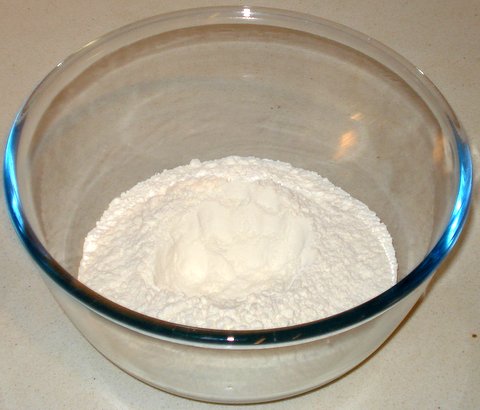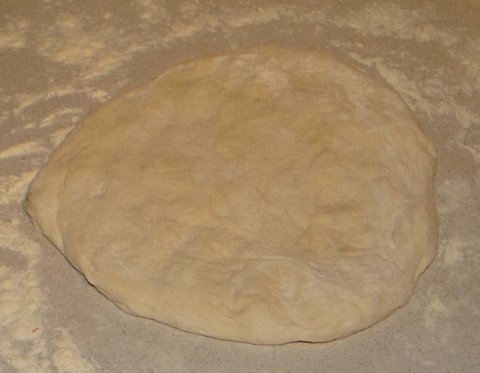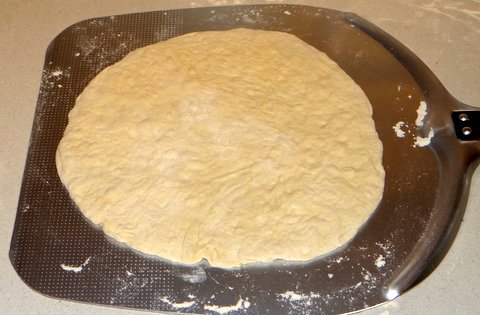Although baking pizza on an aluminum plate under the broiler was a major improvement, I was not completely satisfied as it was very hard to stretch the dough. It kept retracting. I had also read in many sources that real pizza dough should have no sugar or olive oil, which I did include to let it brown more easily. So I did some more research and found an interesting article on Serious Eats about letting dough cold fermet for several days rather than letting it rise in a few hours. I gave it a try, and the results were amazing! The dough stretched very easily, browned like a charm, and the crust had great bubbles and a very good taste! And it doesn’t even require any kneading. The only drawback is that you need to know 3-5 days in advance when you’d like to eat the best home-made pizza you’ve ever had. Serious Eats explains what happens in the dough while it’s in your fridge and why you have to wait for 3-5 days. This is how I will be making pizza from now on! Here’s how to do it yourself.
Ingredients
For 2 pizzas Margherita (25 cm/10″)
250 grams (1 2/3 cups) 00 flour [100%]
10 grams fresh bread yeast [4%]
5 grams (1 tsp) salt [2%]
163 ml (2/3 cups) lukewarm water [65%]
For the topping
4 Tbsp sieved tomatoes (passata)
pinch of salt
pinch of sugar
pinch of dried oregano
1 Tbsp extra virgin olive oil
125 grams (1/4 pound) mozzarella di bufala
Preparation
Put the flour in a bowl.
But a bit of the water in a bowl and crumble the yeast into it.
Dissolve the salt in the remaining water.
Stir the yeast to let it dissolve as well.
Add the yeast mixture and the salted water to the flour.
Mixed with your hands until there is no flour left.
Cover with plastic wrap and refrigerate for 3 to 5 days (!).
The dough will have increased in volume and the surface will look a bit like the moon.
Put the dough on a lightly floured work surface and give it a nice shape.
Divide the dough into two pieces of equal weight, dust them lightly with flour and put them into individual bowls. Cover the bowls with plastic wrap and let them rise at room temperature until doubled in volume, about two hours. Meanwhile, preheat your oven with a pizza plate (preferably aluminum) at the highest setting.
When the dough has doubled in volume, it is time to stretch it. First dust it with flour on all sides so it won’t stick.
Stretch it with your hands, turning the dough while you do it and trying not the push too much on the edges so they remain as airy as possible. Then pick up the dough and stretch it in the air. There are some nice videos on Serious Eats that show you how to do this.
Dust the peel with flour and put the stretched dough on the peel.
Mix the sieved tomatoes, salt, sugar, olive oil, and oregano and spread out 2 Tbsp of the mixture on top of the pizza, leaving the edges bare. Dot with shredded mozzarella (which has been patted dry carefully with paper towels).
Bake the pizza for 2-4 minutes until the top is slightly charred (see this post for a more involved explanation).
As you can see without any oil or sugar, the top of the pizza started to char after only 3 minutes! The edge has also risen very nicely.


















Gosh, this looks sooo terrfic ! I’m so loving it! =D
LikeLike
Thanks for visiting! Hope you’ll become a regular around here.
LikeLike
Where I work, we always make pizza dough one or two days before as it is much easier to stretch. The problem is that, at home, that requires some planning and my pizza cravings just strike unexpectedly! Some chefs add a little bit of honey to the dough, instead of sugar – not Italian at all but quite pleasant
LikeLike
I plan most of my cooking in advance because that way I only have to shop once a week, and I cook more interesting things.
LikeLike
I do this method for bread all the time. However, I find that I must start with ice cold water or the fermentation takes off too fast.
LikeLike
Interesting. How can you tell it’s too fast?
LikeLike
Did you use sugar in the dough?
LikeLike
Hi Stefan, Just back from a couple of weeks in France. I got to cook pizza in an outdoor wood fired oven. The dough was my first ever. More of the outcome in a later post. I love what you are doing here. You do seem to specialise in preparing food for days on end.
Best,
Conor
LikeLike
Hi Conor, welcome back! Hope hou’ve had a great time in France. The wood fired oven sounds great! I’ve never used one yet. I just blog about all the interesting stuff that I eat myself, and blogging has become an incentive to cook more interesting stuff and experiment more rather than preparing the same dishes over and over again.
LikeLike
I, too, discovered this method a while back, and have never been able to make same-day pizza dough again. Even the crappiest dough seems to be redeemed by a few days in the fridge.
LikeLike
I’m going to try it for bread as well. Have you ever tried that?
LikeLike
I retard the dough overnight in the fridge every time I make bread, but haven’t done it more than a couple days.
LikeLike
I can hardly even plan far enough in advance for tonight’s dinner! I will have to try making this & forgetting it in the fridge, then making a spontaneous pizza when I find it. :). The idea makes sense to me, though–like the no-knead bread dough.
LikeLike
According to Serious Eats, the best window is between 3 and 6 days and after that it starts to get funky, although the fermentation speed does depend on the temperature in your fridge.
LikeLike
This sounds like it might taste a bit like the dough at my favorite italian restaurant in Portland (Nostrana, for anyone who is in town). It is perfect with a very subtle sourdough taste. I’d love to try this.
LikeLike
Let me know how it turns out!
LikeLike